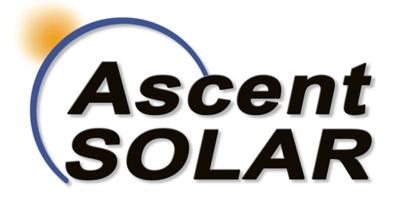Mon, Nov 02, 2015
Ascent Solar Technologies, Bye Aerospace Working Together On The Project
A unique aircraft to fill the gap between mapping and surveillance of Mars from orbital satellites and ground-based rovers is under development by Ascent Solar Technologies and Bye Aerospace.

The aircraft, known as the "Mars SOLESA" ("solar electric survey aircraft")," is a unique approach taken by Bye Aerospace allowing for closer investigation of the Martian surface with greater resolution and flexibility than the orbital satellites currently operating above the surface, but with far greater range and perspective than rovers. In conjunction with solar power provided by Ascent Solar, the Mars SOLESA concept will enable the vehicle to fly through the Martian atmosphere, gathering pertinent and novel data along the way.
Ascent Solar PV enables day-time recharging of the SOLESA batteries. The fresh charge allows multiple series of flights. Special rugged landing gear, combined with cutting edge ground sensing technology, enable autonomous landing site selection and short takeoff and landing distances. By flying at altitudes of a few hundred up to a few thousand feet above the Martian surface, the vehicle can cover more area in less time than the family of rovers currently employed on the surface, while maintaining greater resolution and perspective.
"With the advances we are making in solar-electric propulsion for manned and unmanned aircraft, the next logical step is to turn our attention to important exploration projects such as Mars SOLESA" George Bye, CEO & Chairman of Bye Aerospace said. "We have worked with Ascent Solar on several of our innovations, and commend them for their forward vision."

"We've had our eye on Mars from the beginning, from ground-based power stations to atmospheric-based operations," said Joe Armstrong, CTO of Ascent Solar. "The development of the Mars SOLESA with Bye Aerospace matches up well with our internal development of a higher performance PV product that gives the SOLESA an impressive performance envelope. We have been working with Bye Aerospace for some time on this vehicle as it leans heavily upon both our unmanned aerial vehicle (UAV) and high-altitude long-endurance (HALE) projects and is a perfect intersection of several key improvements in performance that are in process."
More News
Aero Linx: Aviators Code Initiative (ACI) Innovative tools advancing aviation safety and offering a vision of excellence for aviators. The ACI materials are for use by aviation pra>[...]
Make Sure You NEVER Miss A New Story From Aero-News Network Do you ever feel like you never see posts from a certain person or page on Facebook or Instagram? Here’s how you c>[...]
From 2016 (YouTube Edition): Who You Gonna Call When You Have a Rocket Engine that Needs a Spacecraft? While at EAA AirVenture 2016, ANN CEO and Editor-In-Chief, Jim Campbell, sat >[...]
"In my opinion, if this isn't an excessive fine, I don't know what is... The odds are good that we're gonna be seeking review in the United States Supreme Court. So we gotta muster>[...]
Expedite Used by ATC when prompt compliance is required to avoid the development of an imminent situation. Expedite climb/descent normally indicates to a pilot that the approximate>[...]
 ANN's Daily Aero-Linx (04.30.25)
ANN's Daily Aero-Linx (04.30.25) ANN FAQ: Turn On Post Notifications
ANN FAQ: Turn On Post Notifications Classic Aero-TV: Agile Aeros Jeff Greason--Disruptive Aerospace Innovations
Classic Aero-TV: Agile Aeros Jeff Greason--Disruptive Aerospace Innovations Aero-News: Quote of the Day (04.30.25)
Aero-News: Quote of the Day (04.30.25) ANN's Daily Aero-Term (04.30.25): Expedite
ANN's Daily Aero-Term (04.30.25): Expedite




